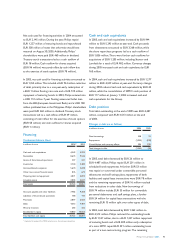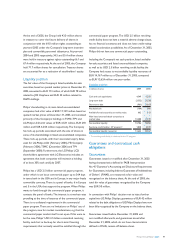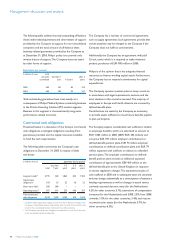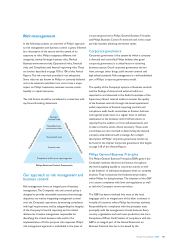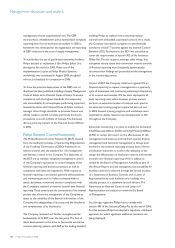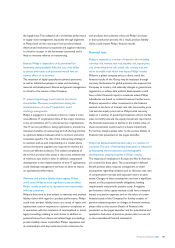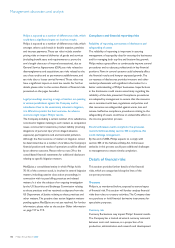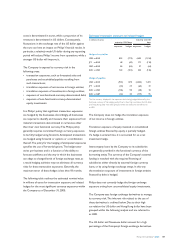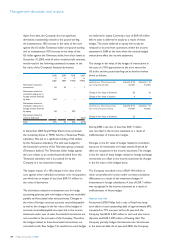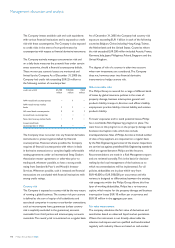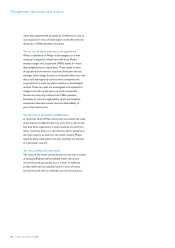Philips 2005 Annual Report Download - page 104
Download and view the complete annual report
Please find page 104 of the 2005 Philips annual report below. You can navigate through the pages in the report by either clicking on the pages listed below, or by using the keyword search tool below to find specific information within the annual report.Philips Annual Report 2005104
Philips’ investments in the “sense and simplicity” media
campaign, with a focus on simplifying the interaction with
its customers, translating awareness into preference and
improving its international brand recognition, could have
less impact than projected.
Philips has made great investments in the reshaping of
the Group into a more market-driven company focusing
on delivering advanced and easy-to-use products and easy
relationships with Philips for its customers. The brand
promise of “sense and simplicity” is important for both
external and internal development. If Philips fails to deliver
on its “sense and simplicity” concept, growth
opportunities may be hampered.
Market/Business environment risks
As Philips’ business is global, its operations are exposed
to economic and political developments in countries
across the world, which could adversely impact its
revenues and income.
The business environment is infl uenced by economic and
political uncertainties, which continue to affect the global
economy and the international capital markets. Economic
and political developments could have a material adverse
effect on Philips’ operating results.
Philips’ overall performance in the coming years is strongly
dependent on realizing its growth ambitions in Asia.
Besides representing a vital consumer market, Asia is also
an important production, sourcing and design center for
Philips. Philips faces strong competition to attract the best
talent in tight labor markets and intense competition
from both local Asian companies as well as other global
players for market share in Asia. Philips must leverage
the investment in its global brand positioning in the
Asian markets to build greater consumer preference.
Philips is dependent on a decreasing number of
business partners.
Further globalization and concentration of its customer
and supply base makes Philips increasingly dependent on
a smaller number of business partners, posing challenges
to existing management and control structures in many
of its businesses.
Philips is increasing its exposure to markets with a higher
complexity, and is facing continued competition.
Different markets face different complexities. The Company’s
divisions are operating in a variety of markets. Philips
continually faces competitive challenges such as the cyclical
nature of certain sectors (especially Semiconductors),
rapid technological change, evolving standards, shortening
product life cycles and price erosion. Lighting’s entry into
dynamic semiconductor- and consumer-related markets
makes it more vulnerable to volatility.
Philips’ global presence exposes the Company to regional
and local regulatory rules, which may interfere with the
realization of business opportunities and investments in
the countries in which the Company operates.
Philips has established subsidiaries in over 60 countries.
The subsidiaries are exposed to changes in governmental
regulations and unfavorable political developments, which
may limit the realization of business opportunities or impair
local Philips investment. An increased focus on medical
and health care increases the exposure to highly regulated
markets, where obtaining clearances or approvals for new
products is of great importance, and the dependency on
the funding available for healthcare systems.
Operational risks
Improvement in Philips’ product creation process and
increased speed in innovation-to-market is important to
realize Philips’ profi table growth ambitions.
Further improvements in Philips’ product creation process,
ensuring timely delivery of new products at lower cost
and upgrading of customer service levels to create
sustainable competitive advantages, are important in
realizing the profi table growth ambitions. The emergence
of new low-cost players, particularly in Asia, further
underlines the importance of improvements in the product
creation process. In addition, in order to gain market share
and maintain its competitive position, Philips needs to
achieve increased speed in innovation-to-market processes,
ensuring that consumer insights are fully captured and
translated into product creations.
If Philips is unable to ensure effective supply chain
management, the Company may be unable to sustain its
competitive position in its markets.
The businesses in which Philips is engaged are intensely
competitive. Initiatives to reduce assets through outsourcing
will require increased management focus with respect to
Management discussion and analysis



